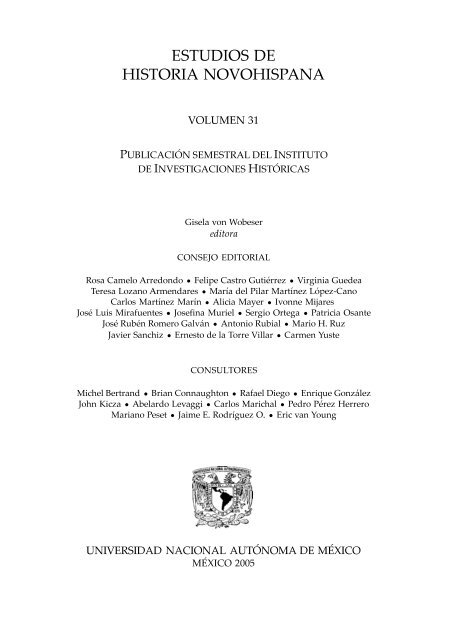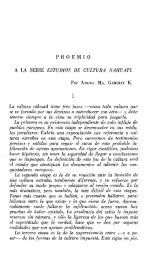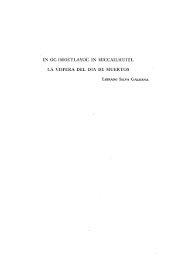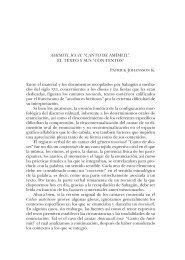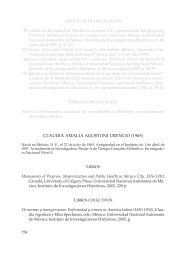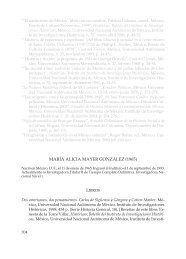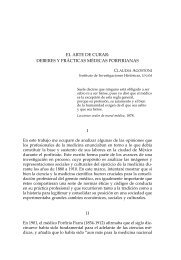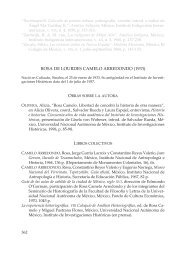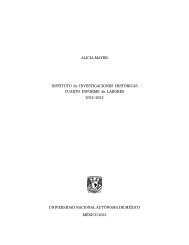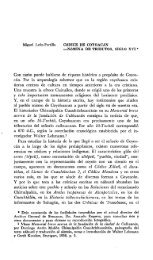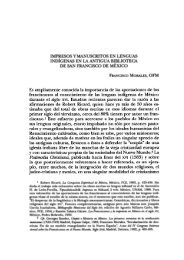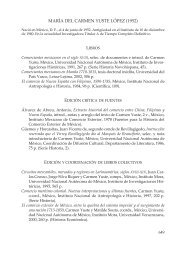NOVOHISPANA 31 1as - Instituto de Investigaciones Históricas ...
NOVOHISPANA 31 1as - Instituto de Investigaciones Históricas ...
NOVOHISPANA 31 1as - Instituto de Investigaciones Históricas ...
Create successful ePaper yourself
Turn your PDF publications into a flip-book with our unique Google optimized e-Paper software.
ESTUDIOS DE<br />
HISTORIA <strong>NOVOHISPANA</strong><br />
VOLUMEN <strong>31</strong><br />
PUBLICACIÓN SEMESTRAL DEL INSTITUTO<br />
DE INVESTIGACIONES HISTÓRICAS<br />
Gisela von Wobeser<br />
editora<br />
CONSEJO EDITORIAL<br />
Rosa Camelo Arredondo • Felipe Castro Gutiérrez • Virginia Gue<strong>de</strong>a<br />
Teresa Lozano Armendares • María <strong>de</strong>l Pilar Martínez López-Cano<br />
Carlos Martínez Marín • Alicia Mayer • Ivonne Mijares<br />
José Luis Mirafuentes • Josefina Muriel • Sergio Ortega • Patricia Osante<br />
José Rubén Romero Galván • Antonio Rubial • Mario H. Ruz<br />
Javier Sanchiz • Ernesto <strong>de</strong> la Torre Villar • Carmen Yuste<br />
CONSULTORES<br />
Michel Bertrand • Brian Connaughton • Rafael Diego • Enrique González<br />
John Kicza • Abelardo Levaggi • Carlos Marichal • Pedro Pérez Herrero<br />
Mariano Peset • Jaime E. Rodríguez O. • Eric van Young<br />
UNIVERSIDAD NACIONAL AUTÓNOMA DE MÉXICO<br />
MÉXICO 2005
ESTUDIOS DE HISTORIA <strong>NOVOHISPANA</strong> es una publicación semestral editada por el <strong>Instituto</strong><br />
<strong>de</strong> <strong>Investigaciones</strong> <strong>Históricas</strong> <strong>de</strong> la UNAM, Circuito Mario <strong>de</strong> la Cueva, Ciudad Universitaria,<br />
Delegación Coyoacán, 04510, México, D. F. Editora responsable: Gisela von Wobeser. Número<br />
<strong>de</strong> Certificado <strong>de</strong> Licitud <strong>de</strong> Título: 10479, Número <strong>de</strong> Certificado <strong>de</strong> Licitud <strong>de</strong> Contenido:<br />
7393, Número <strong>de</strong> Reserva al Título en Derecho <strong>de</strong> Autor: 000822/97. Distribuido por la<br />
Dirección General <strong>de</strong> Publicaciones y Fomento Editorial <strong>de</strong> la UNAM, Avenida <strong>de</strong>l IMAN, s/n,<br />
Ciudad Universitaria, Delegación Coyoacán, 04510, México, D. F. Impreso en Hemes<br />
Impresores, Cerrada Tonantzin núm. 6, Colonia Tlaxpana, México, D. F.<br />
La responsabilidad por las colaboraciones que se publican en la revista<br />
es exclusiva <strong>de</strong> los autores.<br />
Articles appearing in this journal are abstracted and in<strong>de</strong>xed in<br />
HISTORICAL ABSTRACTS and AMERICA: HISTORY AND LIFE<br />
Asimismo, los índices aparecen en<br />
BIBLIOGRAFÍA DIECIOCHISTA, HANDBOOK OF LATIN AMERICAN STUDIES,<br />
HISPANIC AMERICAN PERIODICAL INDEX<br />
y CITAS LATINOAMERICANAS EN CIENCIAS SOCIALES Y HUMANIDADES<br />
(CLASE)<br />
Primera edición: 2005<br />
DR © 2005, Universidad Nacional Autónoma <strong>de</strong> México<br />
Ciudad Universitaria, 04510. México, D. F.<br />
INSTITUTO DE INVESTIGACIONES HISTÓRICAS<br />
Impreso y hecho en México<br />
ISSN 968-837-535-7
Volumen <strong>31</strong>, julio-diciembre 2004, ISSN 968-837-535-7<br />
SUMARIO<br />
Autores . . . . . . . . . . . . . . . . . . . . . . . . . . . .<br />
Resúmenes . . . . . . . . . . . . . . . . . . . . . . . . . .<br />
Abstracts . . . . . . . . . . . . . . . . . . . . . . . . . . . .<br />
5-7<br />
9-11<br />
13-15<br />
ARTÍCULOS<br />
¿Herejes en el claustro? Monjas ante la inquisición novohispana<br />
<strong>de</strong>l siglo XVIII, <strong>de</strong> Antonio Rubial García . . . . . . . .<br />
“En el nombre <strong>de</strong>l Señor…” Ban<strong>de</strong>ras rojinegras en la guerra<br />
<strong>de</strong> in<strong>de</strong>pen<strong>de</strong>ncia novohispana, 1811-1814, <strong>de</strong> Moisés<br />
Guzmán Pérez . . . . . . . . . . . . . . . . . . . . . . .<br />
La justicia mercantil en la Casa <strong>de</strong> la Contratación <strong>de</strong> Sevilla en<br />
el siglo XVI, <strong>de</strong> Marta Milagros <strong>de</strong>l Vas Mingo . . . . .<br />
El surgimiento <strong>de</strong> la familia nuclear en México, <strong>de</strong> Rosario<br />
Esteinou . . . . . . . . . . . . . . . . . . . . . . . . .<br />
19-38<br />
39-72<br />
73-97<br />
99-136<br />
Estrategias para el control <strong>de</strong>l agua en Oaxaca colonial, <strong>de</strong><br />
Isabel Fernán<strong>de</strong>z Tejedo, Georgina Endfield y Sarah<br />
O’Hara . . . . . . . . . . . . . . . . . . . . . . . . .<br />
137-198<br />
RESEÑAS<br />
Roger Bartra, Transgresión y melancolía en el México colonial<br />
(María <strong>de</strong>l Carmen Vázquez Mantecón) . . . . . . .<br />
201-209
AUTORES<br />
ANTONIO RUBIAL GARCÍA. Doctor en Filosofía y Letras por la Universidad<br />
<strong>de</strong> Sevilla (España) y en Historia <strong>de</strong> México por la<br />
Facultad <strong>de</strong> Filosofía y Letras <strong>de</strong> la Universidad Nacional Autónoma<br />
<strong>de</strong> México (UNAM), don<strong>de</strong> es profesor <strong>de</strong> tiempo completo.<br />
Es autor, entre otras obras, <strong>de</strong> Santa María Tonantzintla,<br />
un pueblo, un templo (1961); El convento agustino y la sociedad colonial,<br />
1533-1630 (1989); Una monarquía criolla. La provincia agustina<br />
<strong>de</strong> México en el siglo XVII (1990); Domus Aurea. La capilla <strong>de</strong>l<br />
Rosario <strong>de</strong> Puebla, un programa iconográfico <strong>de</strong> la Contrarreforma<br />
(1990); La hermana pobreza. El franciscanismo: <strong>de</strong> la Edad Media a<br />
la evangelización novohispana (1996); La plaza, el palacio y el convento.<br />
La Ciudad <strong>de</strong> México en el siglo XVII (1998), y La santidad<br />
controvertida: hagiografía y conciencia criolla alre<strong>de</strong>dor <strong>de</strong> los venerables<br />
no canonizados <strong>de</strong> Nueva España (1999).<br />
MOISÉS GUZMÁN PÉREZ. Doctor en Historia por la Universidad<br />
<strong>de</strong> París I, Panteón-Sorbona. Es profesor <strong>de</strong> tiempo completo<br />
en el <strong>Instituto</strong> <strong>de</strong> <strong>Investigaciones</strong> <strong>Históricas</strong> <strong>de</strong> la Universidad<br />
Michoacana <strong>de</strong> San Nicolás <strong>de</strong> Hidalgo. Pertenece al Sistema<br />
Nacional <strong>de</strong> Investigadores, en don<strong>de</strong> tiene el nivel I. Se ha especializado<br />
en la historia política y cultural mexicana <strong>de</strong> los<br />
siglos XVIII y XIX. Ha publicado: Tuzantla: historia en Tierra Caliente<br />
(1991), La Junta <strong>de</strong> Zitácuaro, 1811-1813. Hacia la institucionalización<br />
<strong>de</strong> la insurgencia (1994), En <strong>de</strong>fensa <strong>de</strong> mi patria y <strong>de</strong><br />
mi persona... Benedicto López y su lucha por la in<strong>de</strong>pen<strong>de</strong>ncia (1995),<br />
José María Liceaga. Militar y político insurgente, 1782-1818 (2001)<br />
y Miguel Hidalgo y el gobierno insurgente en Valladolid (2003).<br />
MARTA MILAGROS DEL VAS MINGO. Profesora titular en la Universidad<br />
Complutense <strong>de</strong> Madrid (Facultad <strong>de</strong> Geografía e Historia,<br />
Departamento <strong>de</strong> Historia <strong>de</strong> América I). Especialista en la<br />
Historia <strong>de</strong>l Derecho Indiano, ha publicado, entre otras, las si-
6 AUTORES<br />
guientes obras: la edición y estudios <strong>de</strong>l Diccionario <strong>de</strong> Gobierno<br />
y Legislación <strong>de</strong> Indias <strong>de</strong> Manuel Josef <strong>de</strong> Ayala (1988-1996); Las<br />
capitulaciones <strong>de</strong> Indias (1989); Los consulados en el tráfico indiano<br />
(2000); Las leyes <strong>de</strong>l Mar en la época <strong>de</strong> Carlos V (2000); y La avería<br />
en el tráfico marítimo-mercantil indiano (2004), estos dos últimos<br />
junto con Miguel Luque Talaván. Igualmente es autora <strong>de</strong> cerca<br />
<strong>de</strong> un centenar <strong>de</strong> artículos.<br />
ROSARIO ESTEINOU. Doctora en Sociología por la Universidad <strong>de</strong><br />
Turín, en Italia. Es profesora investigadora <strong>de</strong>l Centro <strong>de</strong> <strong>Investigaciones</strong><br />
y Estudios Superiores en Antropología Social<br />
(CIESAS). Des<strong>de</strong> hace 15 años ha trabajado en el campo <strong>de</strong> la<br />
sociología <strong>de</strong> la familia. Ha incursionado en distintas disciplinas<br />
—antropología, sociología, <strong>de</strong>mografía e historia—, con el<br />
fin <strong>de</strong> ampliar su enfoque sobre las familias en México. Ha trabajado<br />
temáticas como: familia y parentesco, formación familiar,<br />
estructuración <strong>de</strong> roles, estrategias <strong>de</strong> supervivencia y<br />
cultura, parentalidad y dinámica <strong>de</strong> las relaciones familiares<br />
y <strong>de</strong>sarrollo histórico <strong>de</strong> las formas familiares. Entre sus publicaciones<br />
recientes se encuentran: “La parentalidad en la familia:<br />
cambios y continuida<strong>de</strong>s”; “La juventud y los jóvenes<br />
como construcción social” y “Fragilidad y recomposición <strong>de</strong><br />
las relaciones familiares”.<br />
ISABEL FERNÁNDEZ TEJEDO. Es doctora en Historia Económica y<br />
Social, por l’École <strong>de</strong>s Hautes Étu<strong>de</strong>s en Sciences Sociales, París.<br />
Fue investigadora <strong>de</strong>l Centro <strong>de</strong> Estudios Mayas, UNAM<br />
y profesora titular <strong>de</strong> la UAM, Iztapalapa. Como investigador<br />
asociado al Departamento <strong>de</strong> Geografía, Universidad <strong>de</strong><br />
Nottingham, Inglaterra, participa con las coautoras en un proyecto<br />
<strong>de</strong> investigación sobre las respuestas agrarias a los cambios<br />
climáticos extremos en el México colonial. Ha publicado<br />
varios libros: Historia colonial <strong>de</strong> México: implantación y <strong>de</strong>sarrollo<br />
<strong>de</strong>l sistema <strong>de</strong> encomiendas (1995); La tarjeta postal mexicana (1994);<br />
La comunidad indígena maya <strong>de</strong> Yucatán (1990); Tierra profanada<br />
(1992); y La agricultura entre los antiguos mayas (1982). Tiene artículos<br />
en diversas revistas como Journal of Historical Geography,<br />
Environmental History, Climatic Change, Historias, Arqueología<br />
Mexicana, entre otras.
AUTORES 7<br />
GEORGINA H. ENDFIELD. Es senior lecture <strong>de</strong> Geografía en la Universidad<br />
<strong>de</strong> Nottingham, Inglaterra. Sus investigaciones incluyen<br />
temas <strong>de</strong> historia ambiental, cambios climáticos, percepción<br />
ambiental, conflictos sobre recursos naturales y uso<br />
<strong>de</strong> documentos históricos y mapas para la reconstrucción ambiental.<br />
Ha publicado en varias revistas: Annals of the Association<br />
of American Geographers, Imago Mundi, Land Degradation and<br />
Development, Climatic Change, Environmental History, Environment<br />
and History, Colonial Latin American Review y Southern<br />
African Journal of Science. Actualmente dirige una investigación<br />
sobre las respuestas agrarias a los cambios climáticos extremos<br />
en el México colonial y una historia <strong>de</strong>l clima en África<br />
<strong>de</strong>l Sur.<br />
SARAH O’HARA. Es profesora <strong>de</strong>l Departamento <strong>de</strong> Geografía <strong>de</strong><br />
la Universidad <strong>de</strong> Nottingham, Inglaterra. Tiene varios títulos<br />
académicos <strong>de</strong> la Universidad <strong>de</strong> Liverpool, Alberta y<br />
Oxford. Sus campos <strong>de</strong> interés abarcan temas <strong>de</strong> interacción<br />
humana y ambiental, medios ambientes secos, cambios ambientales<br />
recientes y pasados en México y estrategias y manejo<br />
<strong>de</strong> agua en las antiguas Repúblicas Soviéticas <strong>de</strong> Asia<br />
Central. Ha publicado numerosos artículos en revistas como<br />
Geopolítics, The Geographical Journal and Water, Journal of<br />
Historical Geography, Environmental History y Climatic Change,<br />
entre otras.
RESÚMENES<br />
Antonio Rubial García, ¿Herejes en el claustro? Monjas ante la inquisición<br />
novohispana <strong>de</strong>l siglo XVIII.<br />
En el siglo XVIII, la Inquisición levantó información sobre algunas<br />
religiosas que habitaban en los conventos <strong>de</strong> México, Oaxaca y<br />
Atlixco. Las acciones y palabras <strong>de</strong> estas monjas fueron consi<strong>de</strong>radas<br />
heréticas por algunas <strong>de</strong> sus compañeras que las <strong>de</strong>nunciaron.<br />
La Inquisición se portó muy benévola sobre estos casos,<br />
muestra <strong>de</strong> los cambios que había traído consigo el Siglo <strong>de</strong> las<br />
Luces.<br />
Descriptores: Inquisición, conventos <strong>de</strong> monjas, <strong>de</strong>litos contra la fe,<br />
teología y medicina.<br />
Moisés Guzmán Pérez, “En el nombre <strong>de</strong>l Señor…” Ban<strong>de</strong>ras rojinegras<br />
en la guerra <strong>de</strong> in<strong>de</strong>pen<strong>de</strong>ncia novohispana, 1811-1814.<br />
Una forma <strong>de</strong> expresión <strong>de</strong>l carácter religioso que tuvo la guerra<br />
<strong>de</strong> in<strong>de</strong>pen<strong>de</strong>ncia en la Nueva España fue, entre otras, el uso <strong>de</strong><br />
símbolos, colores y emblemas con características muy bien <strong>de</strong>finidas.<br />
A través <strong>de</strong>l estudio <strong>de</strong> dos singulares ban<strong>de</strong>ras rojinegras,<br />
confeccionadas por los insurgentes entre los años <strong>de</strong> 1811 y 1812, se<br />
pue<strong>de</strong> apreciar la enorme importancia que adquirió el factor religioso<br />
como elemento unificador y como legitimador en el momento<br />
<strong>de</strong>l conflicto. A través <strong>de</strong> su análisis vexilológico y contextual,<br />
se observa que la <strong>de</strong>fensa <strong>de</strong> la religión católica entre los insurgentes<br />
no se amparó <strong>de</strong> manera exclusiva en la virgen <strong>de</strong> Guadalupe o<br />
en otras advocaciones marianas, sino en el nombre <strong>de</strong>l Señor, y que<br />
dicha <strong>de</strong>fensa estuvo orientada a salvaguardar los fueros y los privilegios<br />
<strong>de</strong> los ministros <strong>de</strong>l culto católico, prerrogativas <strong>de</strong> las
10<br />
RESÚMENES<br />
que habían gozado durante muchos años y que <strong>de</strong>s<strong>de</strong> 1795 fueron<br />
afectadas por el régimen <strong>de</strong> los Borbones.<br />
Descriptores: José María Cos, Mariano Matamoros, in<strong>de</strong>pen<strong>de</strong>ncia,<br />
estandarte, ban<strong>de</strong>ra, religión, guerra santa.<br />
Marta Milagros <strong>de</strong>l Vas Mingo, La justicia mercantil en la Casa <strong>de</strong> la<br />
Contratación <strong>de</strong> Sevilla en el siglo XVI.<br />
Los consulados <strong>de</strong> comercio fueron aglutinadores <strong>de</strong> la actividad<br />
<strong>de</strong> los comerciantes y sirvieron para dirimir sus pleitos. Su labor<br />
jurisdiccional en lo mercantil fue fundamental para el <strong>de</strong>sarrollo<br />
<strong>de</strong>l comercio en todos los tiempos y en todos los espacios geográficos.<br />
El comercio indiano, centralizado en la ciudad <strong>de</strong> Sevilla,<br />
también fue su beneficiario. En la presente investigación se analiza<br />
la aplicación <strong>de</strong> la justicia <strong>de</strong> carácter mercantil en la Casa <strong>de</strong> la<br />
Contratación <strong>de</strong> Sevilla <strong>de</strong>s<strong>de</strong> sus momentos fundacionales, así<br />
como la legislación que la corona española dictó para solventar<br />
los problemas <strong>de</strong>rivados <strong>de</strong>l tráfico comercial indiano.<br />
Descriptores: Derecho Indiano, justicia mercantil, Casa <strong>de</strong> la Contratación,<br />
Sevilla, consulados.<br />
Rosario Esteinou, El surgimiento <strong>de</strong> la familia nuclear en México.<br />
En la actualidad, la familia nuclear constituye la principal forma<br />
familiar en México. A pesar <strong>de</strong> esta presencia mayoritaria, conocemos<br />
poco sobre sus características y sobre su <strong>de</strong>sarrollo histórico.<br />
Los historiadores han indicado que ya existía <strong>de</strong>s<strong>de</strong> el periodo<br />
colonial pero no se han i<strong>de</strong>ntificado ni sus similitu<strong>de</strong>s ni sus diferencias<br />
respecto <strong>de</strong> la familia nuclear contemporánea o <strong>de</strong> la familia<br />
nuclear occi<strong>de</strong>ntal <strong>de</strong>scrita en la sociología clásica. El objetivo<br />
<strong>de</strong> este artículo es analizar la emergencia <strong>de</strong> la familia nuclear en<br />
México y <strong>de</strong>scribir sus particularida<strong>de</strong>s y diferencias en comparación<br />
con la familia nuclear occi<strong>de</strong>ntal. Esta exploración se realiza<br />
a partir <strong>de</strong> tres dimensiones analíticas: la estructura familiar,<br />
las relaciones familiares y las relaciones <strong>de</strong> parentela. La tesis que<br />
se propone es que, contrariamente a lo que han afirmado algunos
RESÚMENES 11<br />
historiadores, la familia nuclear, <strong>de</strong>s<strong>de</strong> un punto <strong>de</strong> vista sociocultural,<br />
no surgió durante el período colonial.<br />
Descriptores: Historia <strong>de</strong> la familia en México, estructura familiar<br />
en la historia mexicana, relaciones familiares en la historia<br />
mexicana, relaciones <strong>de</strong> parentela en la historia mexicana, familia<br />
nuclear, familia y periodo colonial.<br />
Isabel Fernán<strong>de</strong>z Tejedo, Georgina Endfield y Sarah O’Hara, Estrategias<br />
para el control <strong>de</strong>l agua en Oaxaca colonial.<br />
El resultado <strong>de</strong>l proceso colonizador sobre la propiedad y el uso<br />
<strong>de</strong>l agua en el valle central <strong>de</strong> Oaxaca culminó, como en otros sitios<br />
<strong>de</strong> México, en el acaparamiento <strong>de</strong> los beneficios <strong>de</strong>l líquido<br />
vital por parte <strong>de</strong> los colonos españoles. Si las prerrogativas emanadas<br />
<strong>de</strong> la conquista permitieron que la mitad <strong>de</strong> la tierra quedara<br />
en manos <strong>de</strong> los antiguos cacicazgos y <strong>de</strong>l marqués <strong>de</strong>l Valle,<br />
restringiendo la ocupación <strong>de</strong> la tierra a los colonos y encomen<strong>de</strong>ros,<br />
la propiedad y el uso <strong>de</strong>l agua siguió otro <strong>de</strong>rrotero. A<br />
través <strong>de</strong>l sistema <strong>de</strong> distribución <strong>de</strong> merce<strong>de</strong>s <strong>de</strong> agua y aplicando<br />
los mecanismos legales <strong>de</strong> la economía colonial —renta, venta<br />
y empréstito—, los nuevos pobladores fueron acaparando, lentamente<br />
pero <strong>de</strong> forma inequívoca, los principales recursos acuíferos<br />
<strong>de</strong>l valle. Las estrategias para el control <strong>de</strong>l agua permitieron la<br />
emergencia <strong>de</strong> numerosos ranchos y labores con <strong>de</strong>rechos a uso<br />
<strong>de</strong> agua, en don<strong>de</strong> se concentró el verda<strong>de</strong>ro dominio español <strong>de</strong><br />
la propiedad. El usufructo <strong>de</strong>l agua se aplicó al riego <strong>de</strong> nuevos<br />
cultivos, trigo y caña <strong>de</strong> azúcar, principalmente, y para saciar la<br />
sed <strong>de</strong> los cuantiosos ganados. En los molinos <strong>de</strong> harina y batanes<br />
el agua fue indispensable para accionar las ruedas o para lavar metales<br />
en las minas. La documentación colonial es particularmente<br />
abundante en pleitos y permite conocer no solamente las leyes y la<br />
aplicación <strong>de</strong> la legislación colonial relativa al manejo <strong>de</strong>l agua,<br />
sino también los usos, las costumbres y el reparto comunitario <strong>de</strong>l<br />
líquido, e incluso los problemas ligados al abasto <strong>de</strong>l agua potable<br />
en los pueblos y ciuda<strong>de</strong>s.<br />
Descriptores: propiedad, uso y reparto <strong>de</strong> agua, Marquesado <strong>de</strong>l Valle,<br />
valle <strong>de</strong> Oaxaca, cacicazgos.
ABSTRACTS<br />
Antonio Rubial García. Heretics in the Cloisters? Nuns in the Face<br />
of the Inquisition in 18 th Century New Spain.<br />
In the 18 th century, the Inquisition gathered information on nuns<br />
living in the convents of Mexico, Oaxaca and Atlixco. The actions<br />
and words of these nuns were regar<strong>de</strong>d as heretical by some of<br />
their colleagues, who <strong>de</strong>nounced them. The Inquisition behaved<br />
extremely benevolently in these cases, reflecting the changes<br />
wrought by the Century of Enlightenment.<br />
Key-words: Inquisition, convents, crimes against the faith, theology<br />
and medicine. edicina.<br />
Moisés Guzmán Pérez. “In the name of the Lord…” Black and red<br />
flags during the War of In<strong>de</strong>pen<strong>de</strong>nce in New Spain.<br />
Another expression of the religious nature of the In<strong>de</strong>pen<strong>de</strong>nce<br />
War in New Spain was the use of the symbols, colors and emblems<br />
with well-<strong>de</strong>fined features. The study of two flags manufactured<br />
by the rebels’ between 1811 and 1812 shows the enormous importance<br />
of the religious factor at this time as a unifying and legitimizing<br />
element of the war. The <strong>de</strong>fense of the Catholic religion by<br />
the rebels was not exclusively based on the Virgin of Guadalupe<br />
or other forms of Marian worship but rather on the name of the<br />
Lord. Furthermore this <strong>de</strong>fense was aimed at preserving Catholic<br />
priests’ statutes and privileges.<br />
Key words: José María Cos, Mariano Matamoros, in<strong>de</strong>pen<strong>de</strong>nce,<br />
standard, flag, religion, saintwar.
14 ABSTRACTS<br />
Marta Milagros <strong>de</strong>l Vas Mingo. Mercantile Justice in the Casa <strong>de</strong> la<br />
Contratación in Seville in the 16th Century<br />
Trading consulates coordinated merchants’ activity and settled<br />
their disputes. Their jurisdictional work in mercantile issues was<br />
crucial to the <strong>de</strong>velopment of tra<strong>de</strong> at all times and in all geographical<br />
spheres. Spanish-American tra<strong>de</strong>, centralized in the city<br />
of Seville, also benefited. This article analyzes the application of<br />
mercantile justice in the Casa <strong>de</strong> la Contratación in Seville, from<br />
the time it was foun<strong>de</strong>d, as well as the legislation established<br />
by the Spanish Crown to solve problems related to Spanish-American<br />
tra<strong>de</strong>.<br />
Key words: Spanish American law, mercantile justice, Casa <strong>de</strong> la<br />
Contratación, Seville, consulates.<br />
Rosario Esteinou, The Emergence of the Nuclear Family in Mexico<br />
Although the nuclear family in Mexico is the main form of familial<br />
organization, little is known about its characteristics and historical<br />
<strong>de</strong>velopment. Historians have indicated that the nuclear<br />
family has existed since the colonial period, but there has been no<br />
i<strong>de</strong>ntification of its similarities or differences with the contemporary<br />
nuclear family or with the Western nuclear family <strong>de</strong>scribed<br />
in classical sociology. The article analyzes the emergence of the<br />
nuclear family in Mexico and points to its particularities and differences<br />
in comparison with the Western nuclear family. This exploration<br />
is based on three analytic dimensions: family structure,<br />
family relationships and kinship relationships. The thesis I propose<br />
is that, contrary to what has been stated by some historians, from a<br />
sociocultural point of view, the nuclear family did not emerge during<br />
the colonial period.<br />
Key-words: History of the family in Mexico, family structure in<br />
Mexican history, family relations in Mexican history, kinship<br />
links in Mexican history, nuclear family, family and colonial<br />
period.
ABSTRACTS<br />
15<br />
Isabel Fernán<strong>de</strong>z Tejedo, Georgina Endfield and Sarah O’Hara,<br />
Strategies for Controlling Water in Colonial Oaxaca.<br />
European colonization of the Valle <strong>de</strong> Oaxaca, Mexico resulted in<br />
the monopolization of water by Spanish colonists. While much of<br />
the land remained in the hands of the old chieftainships and<br />
of Marquis of the Valle <strong>de</strong> Oaxaca, water ownership and use within<br />
these lands was a different matter. Thanks to early colonial property<br />
legislation involving the free distribution of water, new settlers<br />
were able to progressively monopolize the main water-bearing resources<br />
of the Valle <strong>de</strong> Oaxaca, allowing a concentration of Spanish-owned<br />
land holdings with sole rights to water use. Water was<br />
essential for irrigating the crops introduced into the region by the<br />
Spanish, mainly wheat and sugar cane and was also nee<strong>de</strong>d for livestock,<br />
particularly cattle. Water was required to operate the flour<br />
mills and was also crucial to the mining industry. It is not surprising,<br />
therefore, that there was consi<strong>de</strong>rable competitition for and<br />
contention over water access, ownership and use in the Valley.<br />
Colonial documentation is particularly rich in this respect and not<br />
only provi<strong>de</strong>s insights into colonial water legislation, but also enables<br />
us to investigate the uses, customs and distribution of water<br />
among different social groups as well as the problems of supplying<br />
safe drinking water to the communities, towns and cities of<br />
the Valley.<br />
Key words: water ownership, use and distribution, marquis of the<br />
Valle <strong>de</strong> Oaxaca, Valle <strong>de</strong> Oaxaca, chieftainships.


